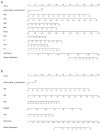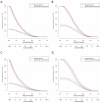Development and validation of a nomogram to better predict hypertension based on a 10-year retrospective cohort study in China
- PMID: 34047697
- PMCID: PMC8163499
- DOI: 10.7554/eLife.66419
Development and validation of a nomogram to better predict hypertension based on a 10-year retrospective cohort study in China
Abstract
Background: Hypertension is a highly prevalent disorder. A nomogram to estimate the risk of hypertension in Chinese individuals is not available.
Methods: 6201 subjects were enrolled in the study and randomly divided into training set and validation set at a ratio of 2:1. The LASSO regression technique was used to select the optimal predictive features, and multivariate logistic regression to construct the nomograms. The performance of the nomograms was assessed and validated by AUC, C-index, calibration curves, DCA, clinical impact curves, NRI, and IDI.
Results: The nomogram140/90 was developed with the parameters of family history of hypertension, age, SBP, DBP, BMI, MCHC, MPV, TBIL, and TG. AUCs of nomogram140/90 were 0.750 in the training set and 0.772 in the validation set. C-index of nomogram140/90 were 0.750 in the training set and 0.772 in the validation set. The nomogram130/80 was developed with the parameters of family history of hypertension, age, SBP, DBP, RDWSD, and TBIL. AUCs of nomogram130/80 were 0.705 in the training set and 0.697 in the validation set. C-index of nomogram130/80 were 0.705 in the training set and 0.697 in the validation set. Both nomograms demonstrated favorable clinical consistency. NRI and IDI showed that the nomogram140/90 exhibited superior performance than the nomogram130/80. Therefore, the web-based calculator of nomogram140/90 was built online.
Conclusions: We have constructed a nomogram that can be effectively used in the preliminary and in-depth risk prediction of hypertension in a Chinese population based on a 10-year retrospective cohort study.
Funding: This study was supported by the Hebei Science and Technology Department Program (no. H2018206110).
Keywords: human; hypertension; medicine; nomogram; risk prediction model.
© 2021, Deng et al.
Conflict of interest statement
XD, HH, XW, QL, XL, ZY, HW No competing interests declared
Figures








Similar articles
-
Derivation and internal validation of prediction models for pulmonary hypertension risk assessment in a cohort inhabiting Tibet, China.Elife. 2024 Nov 11;13:RP98169. doi: 10.7554/eLife.98169. Elife. 2024. PMID: 39526735 Free PMC article.
-
A nomogram for predicting unfavorable outcomes of antituberculosis treatment among individuals with AIDS combined with pulmonary tuberculosis in China.Front Immunol. 2025 May 29;16:1594107. doi: 10.3389/fimmu.2025.1594107. eCollection 2025. Front Immunol. 2025. PMID: 40510348 Free PMC article.
-
Predictive nomogram for 28-day mortality risk in mitral valve disorder patients in the intensive care unit: A comprehensive assessment from the MIMIC-III database.Int J Cardiol. 2024 Jul 15;407:132105. doi: 10.1016/j.ijcard.2024.132105. Epub 2024 Apr 25. Int J Cardiol. 2024. PMID: 38677334
-
A nomogram for predicting the 4-year risk of chronic kidney disease among Chinese elderly adults.Int Urol Nephrol. 2023 Jun;55(6):1609-1617. doi: 10.1007/s11255-023-03470-y. Epub 2023 Jan 31. Int Urol Nephrol. 2023. PMID: 36720744 Review.
-
Development of a nomogram for severe influenza in previously healthy children: a retrospective cohort study.J Int Med Res. 2023 Feb;51(2):3000605231153768. doi: 10.1177/03000605231153768. J Int Med Res. 2023. PMID: 36802862 Free PMC article. Review.
Cited by
-
Establishment and evaluation of a risk-prediction model for hypertension in elderly patients with NAFLD from a health management perspective.Sci Rep. 2022 Sep 7;12(1):15138. doi: 10.1038/s41598-022-18718-3. Sci Rep. 2022. PMID: 36071077 Free PMC article.
-
Development and Validation of a Nomogram-Based Prognostic Model to Predict High Blood Pressure in Children and Adolescents-Findings From 342,736 Individuals in China.Front Cardiovasc Med. 2022 Jun 23;9:884508. doi: 10.3389/fcvm.2022.884508. eCollection 2022. Front Cardiovasc Med. 2022. PMID: 35811689 Free PMC article.
-
Development and validation of a model to predict the risk of hypertension using anthropometric indicators in the Chinese population: a retrospective cohort study.Am J Transl Res. 2023 Mar 15;15(3):2207-2219. eCollection 2023. Am J Transl Res. 2023. PMID: 37056806 Free PMC article.
-
Development and Validation of a Nomogram-Based Model to Predict Primary Hypertension Within the Next Year in Children and Adolescents: Retrospective Cohort Study.J Med Internet Res. 2024 Dec 30;26:e58686. doi: 10.2196/58686. J Med Internet Res. 2024. PMID: 39753226 Free PMC article.
-
Construction and internal validation of a novel nomogram for predicting prognosis of infective endocarditis.Sci Rep. 2022 Oct 14;12(1):17249. doi: 10.1038/s41598-022-22173-5. Sci Rep. 2022. PMID: 36241684 Free PMC article.
References
Publication types
MeSH terms
LinkOut - more resources
Full Text Sources
Other Literature Sources
Medical
Miscellaneous

